The NVIDIA GeForce RTX 2080 Ti & RTX 2080 Founders Edition Review: Foundations For A Ray Traced Future
by Nate Oh on September 19, 2018 5:15 PM EST- Posted in
- GPUs
- Raytrace
- GeForce
- NVIDIA
- DirectX Raytracing
- Turing
- GeForce RTX
Wolfenstein II: The New Colossus (Vulkan)
id Software is popularly known for a few games involving shooting stuff until it dies, just with different 'stuff' for each one: Nazis, demons, or other players while scorning the laws of physics. Wolfenstein II is the latest of the first, the sequel of a modern reboot series developed by MachineGames and built on id Tech 6. While the tone is significantly less pulpy nowadays, the game is still a frenetic FPS at heart, succeeding DOOM as a modern Vulkan flagship title and arriving as a pure Vullkan implementation rather than the originally OpenGL DOOM.
Featuring a Nazi-occupied America of 1961, Wolfenstein II is lushly designed yet not oppressively intensive on the hardware, something that goes well with its pace of action that emerge suddenly from a level design flush with alternate historical details.
The highest quality preset, "Mein leben!", was used. Wolfenstein II also features Vega-centric GPU Culling and Rapid Packed Math, as well as Radeon-centric Deferred Rendering; in accordance with the preset, neither GPU Culling nor Deferred Rendering was enabled.
| Wolfenstein II | 1920x1080 | 2560x1440 | 3840x2160 |
| Average FPS |  |
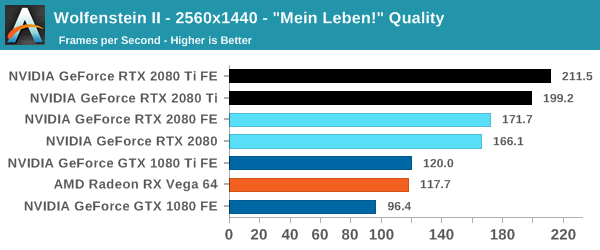 |
 |
| 99th Percentile | 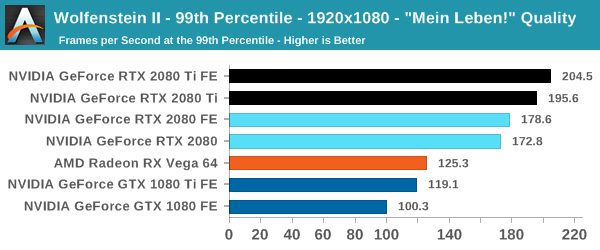 |
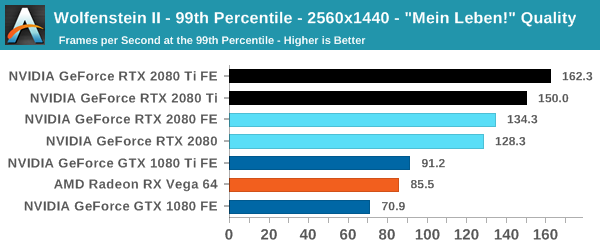 |
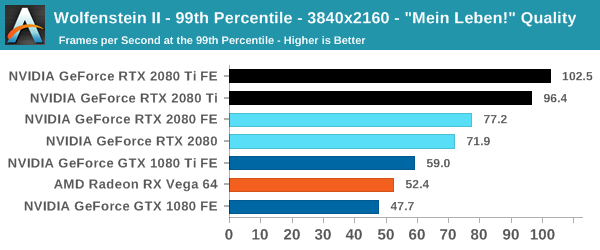 |
I am actually impressed with Wolfenstein II and its Vulkan implementation more than the absurd 250+ framerates, if only because many other games hold back the GPU because of the occurring CPU bottleneck. In DOOM, there was a hard 200fps cap because of engine/implementation limitations, a bit of a corner case, but manufacturers make 240Hz monitors nowadays, too. On a GPU performance profiling side, of course, reducing the CPU bottleneck makes comparing powerful GPUs much easier at 1080p, and with a better signal-to-noise than at 4K.
This is combined with the fact that at 4K, the 20 series are looking a huge 60 to 68% lead over the 10 series, and we'll be cross-referencing these performance deltas with other sections of the game. Even in the case of a 'flat-track bully' scenario where the 2080 Ti is running up the score, the 2080 Ti's speed compared to the 2080 is somewhat less than expected at 24 to 27%. It's a somewhat intriguing result for an optimized Vulkan game, as the game runs and scales generally well across the board; It's also not unnoticed that both the RX Vega cards and GeForce Turing cards outperform their expected positions, though without the graphics workload details it's hard to speculate with substance. With framerates like these, the 4K HDR dream at 144 Hz is a real possibility, and it would be interesting to compare with Titan V and Titan Xp results.


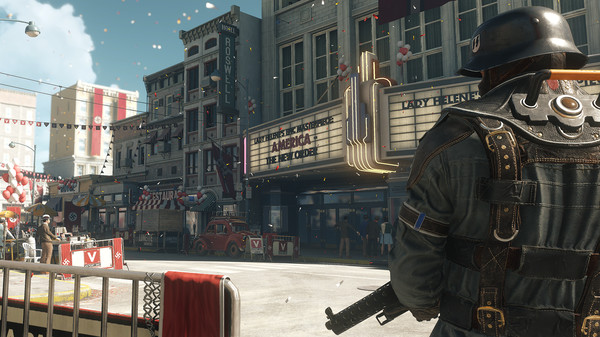









337 Comments
View All Comments
mapesdhs - Thursday, September 27, 2018 - link
Does the site earn anything from your reading their articles? Just curious.sing_electric - Thursday, September 20, 2018 - link
I really wonder how well raytracing will be implemented in the next 1-2 years. My bet is that for many of the titles Nvidia's announced, the effects will be limited and sort of gimicky, and the real benefits will come with titles that are starting development now (or, more likely, in a few months, when devs can look at how the 1st attempts at using RT faired).If my hunch is right, then that means that the RT features are likely to be of little practical use in this generation, since the real benefits won't come until some point after Nvidia's next-gen (7nm? 5?) chips come out with much-improved performance.
MadManMark - Thursday, September 20, 2018 - link
It sounds like the 2080 TI at maybe 1440 might be viable for RT. But yeah, for the most part this is about the future, and starting to get some games out there so for future releses there is not the "chicken & egg" problem they have now (no games to use it for, but reason there are no games is there are no cards to use it).Nvidia clearly sacrificing short-term profitability to establish this base; notice how the 2080 is both priced & performs about the same as the 1080 Ti. With the larger die size despite 12nmFF, driver development costs, etc, there is little doubt in my mind that Nvidia will be making a bigger margin on the 1080 Ti than the 2080. But they want to make it cheap enough so that, even if there is little to gain RIGHT NOW from buying 2080 instead fo 1080 Ti, there is also little lost either.
milkod2001 - Thursday, September 20, 2018 - link
It will have to be AMD who also jumps on raytracing thing first then maybe game developers will take it seriously.MadManMark - Thursday, September 20, 2018 - link
"Bartender, I'll have what milkod2001's having!" ;)El Sama - Thursday, September 20, 2018 - link
RTX 2080 not worth buying right now, 1080ti is cheaper (lol), cooler and performs equal. RTX 2080ti is a 1200+ Card that is around 60% price increase from 1080ti for a 25-28% performance increase? How is that a good purchase? Neither of them are worth buying right now.Toadster - Thursday, September 20, 2018 - link
decisions - 24 monthly payments for an iPhone XS Max? or GTX 2080Ti :)milkod2001 - Thursday, September 20, 2018 - link
Get iPhone if you want to be cool guy, you cannot put RTX 2080ti into your pocket :)Arbie - Thursday, September 20, 2018 - link
THANK YOU for the Ashes of the Singularity benchmark results. The deltas may not translate to other games but show me exactly what to expect from an upgrade.darckhart - Thursday, September 20, 2018 - link
But NVIDIA's key features - such as real time ray tracing and DLSS - aren't being utilized by any games right at launch. In fact, it's not very clear at all when those games might arrive, because NVIDIA ultimately is reliant on developers here.In the Star Wars Reflections demo, we measured the RTX 2080 Ti Founders Edition managing around a 14.7fps average at 4K and 31.4fps average at 1440p when rendering the real time ray traced scene. With DLSS enabled, it jumps to 33.8 and 57.2fps
Direct quotes from article. Price premium for NV tech that (1) will not be in games at launch and may have months of buggy implementation from early adoption and may not have widespread adoption, (2) needs extreme help from DLSS to have usable framerates. Should've been named DTX not RTX.